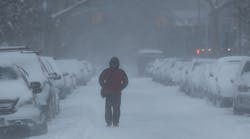If a winter storm should strike, do you have safeguards in place to protect your business and employees? Preparing your business for both short- and long-term interruptions is important.
Additionally, business owners should consider having an action or communications plan for their employees.
In partnership with Agility Recovery, the Small Business Administration developed a checklist for business owners to consider when preparing their companies for emergencies and disaster recoveries. Here are some of their tips:
Before the Storm:
- Check your insurance coverage protection against winter hazards.
- Develop a procedure for restoring electrical services on an item-by-item basis.
- Develop a procedure for relocating salvageable and undamaged stock and supplies.
During the Storm:
- Keep driveways, walkways and doorways clear of snow and ice.
- Open water faucets to let them drip to keep water flowing through the pipes vulnerable to freezing.
- Have the names and phone numbers of your heating contractor, plumber, fire department, insurance agent and building owner accessible.
Shoveling
- If you have employees outside shoveling snow (or if you know they will be shoveling at home) remind them to take frequent breaks and drink plenty of fluids.
- They should warm up their muscles before shoveling with some stretches. Shoveling is strenuous exercise!
- Like any type of lifting, remind them to keep their backs straight and lift with their legs when shoveling, and remind them to shovel small amounts at a time, rather than trying to lift shovels loaded with 50 lbs of wet snow. Also, they should push the snow rather than lift it whenever possible.
- If they are removing snow from the roof, they should be using the same types of fall protection they would use for any work at heights. Remind them that ladder treads can be slippery when icy or wet. Seems like common sense, but we all forget to use common sense at times.
Slippery Surfaces
- Whether you are at work or at home or running pre- or post-storm errands, slippery surfaces can be extremely hazardous. Snow can cover icy sidewalks, and black ice is invisible.
- Wear insulated boots and footwear with non-slip soles.
- Clear sidewalks and walking surfaces and use ice melt so they don’t get slippery.
- To avoid wipeouts, take short steps and walk at a slower pace.
- If you’re walking in the street, walk against traffic and keep an eye out for out-of-control vehicles. If a vehicle loses traction, there isn’t much a driver can do to avoid you even if he or she sees you, so clear out of the way.
- If walking at night or during heavy snow, wear bright or reflective clothing if possible.
Utility crews in the states that will be impacted by the storm are on high alert, airlines are cancelling flights and train stations are shutting down. Stay home, stay warm and stay safe.
Read the all the Safety Tips for Winter Weather on EHS Today.
EHS Today is a New Equipment Digest companion site within Penton's Manufacturing & Supply Chain Group.










